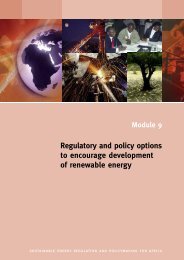Increasing access to energy services in rural areas - REEEP ...
Increasing access to energy services in rural areas - REEEP ...
Increasing access to energy services in rural areas - REEEP ...
Create successful ePaper yourself
Turn your PDF publications into a flip-book with our unique Google optimized e-Paper software.
MODULE 10: INCREASING ACCESS TO ENERGY SERVICES IN RURAL AREAS<br />
page 10.9<br />
The rate of electrification and use of traditional fuels for cook<strong>in</strong>g, two of the most<br />
significant benchmarks for <strong>energy</strong> provision, are not overlaid <strong>in</strong> table 1 as specific<br />
electrification rates <strong>in</strong> <strong>rural</strong> <strong>areas</strong> are difficult <strong>to</strong> obta<strong>in</strong> <strong>in</strong> so many countries, and<br />
statistics on the use of biomass per country are even less available, although<br />
cook<strong>in</strong>g comprises 95 per cent of <strong>energy</strong> use <strong>in</strong> LDCs.<br />
However, the World Energy Assessment estimates that between 1970 and 1990,<br />
<strong>rural</strong> electrification programmes reached about 800 million additional people and<br />
some 500 million saw their lives improve substantially through the use of better<br />
methods for cook<strong>in</strong>g and other <strong>rural</strong> <strong>energy</strong> tasks. 14 While much of the <strong>rural</strong> electrification<br />
programmes were through grid connection, the amount of renewables<br />
now be<strong>in</strong>g utilized <strong>in</strong> LDCs has been estimated <strong>to</strong> be provid<strong>in</strong>g the extra <strong>energy</strong><br />
<strong>services</strong> needed <strong>to</strong> about 25 million people. The renewable <strong>energy</strong> capacity is<br />
made up of 1 million solar home systems (SHS), 150,000 PV and w<strong>in</strong>d powered<br />
cl<strong>in</strong>ics and schools, 50,000 domestic w<strong>in</strong>d turb<strong>in</strong>es, 300,000 solar lanterns (<strong>in</strong><br />
India alone), 150,000 family-hydro units (<strong>in</strong> Ch<strong>in</strong>a and Vietnam) and hundreds of<br />
thousands PV and w<strong>in</strong>d water pumps. 15<br />
But despite the enormous efforts <strong>to</strong> improve <strong>energy</strong> <strong>services</strong> <strong>to</strong> <strong>rural</strong> populations<br />
(<strong>in</strong>clud<strong>in</strong>g the use of renewables) <strong>in</strong> the past thirty <strong>to</strong> forty years, the un-served<br />
population has not decreased significantly <strong>in</strong> absolute numbers – about two billion<br />
people still rely on traditional biomass for cook<strong>in</strong>g and lack clean, safe fuels 16<br />
and 1.7 billion have yet <strong>to</strong> achieve any electrification. 17<br />
So, <strong>energy</strong> provision for all rema<strong>in</strong>s a key problem and challenge for billions of<br />
poor people who often have a limited choice of technologies that convert <strong>energy</strong><br />
<strong>in</strong><strong>to</strong> useful <strong>services</strong>. The technologies most readily available <strong>to</strong> them are typically<br />
<strong>in</strong>efficient or low quality. 18 So they end up pay<strong>in</strong>g much more per unit of useful<br />
<strong>energy</strong> service than the more well off.<br />
On the face of it, this challenge looks formidable, yet <strong>to</strong> meet the basic cook<strong>in</strong>g<br />
needs of two billion people would correspond <strong>to</strong> no more than 1 per cent of global<br />
commercial <strong>energy</strong> consumption 19 and <strong>to</strong> provide the basic electricity needs of offgrid<br />
households and enterprises is certa<strong>in</strong>ly technologically achievable and, us<strong>in</strong>g<br />
the right f<strong>in</strong>anc<strong>in</strong>g <strong>in</strong>struments, often f<strong>in</strong>ancially viable.<br />
14<br />
World Energy Assessment: Overview 2004 Update – United Nations Development Programme, United<br />
Nations Department of Economic and Social Affairs, World Energy Council, 2004, page 59.<br />
15<br />
Greenpeace/The Body Shop – Power <strong>to</strong> tackle poverty, June 2001, ISBN 9073361745, page 9.<br />
16<br />
Greenpeace/The Body Shop – Power <strong>to</strong> tackle poverty.<br />
17<br />
World Energy Assessment, 2002 – United Nations Development Programme, United Nations<br />
Department of Economic and Social Affairs, World Energy Council, 2002.<br />
18<br />
DFID – Energy for the Poor, page 7.<br />
19<br />
Reddy (1999), quoted <strong>in</strong> WEA, 2002.










